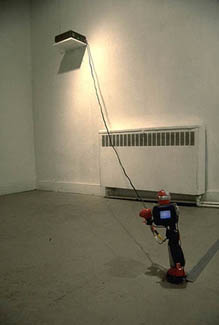
INSTALLATIONS
command escape, 1996, video installation
A handicapped robot (protangonist) is caught midway between power supply (life support system) and video player (antagonist). The robot wears an LCD display upon its back which plays out a loop of continuous explosions assembled from movie trailers.
Installation (detail), 1997, 5min stereo CD soundtrack on a loop
Installation (detail) is a sound installation. The patterns on the wall are derivative of constellations (Orion, Cancer, Gemini, etc.) and circuit board patterns with speakers as their components. The sounds are an orchestration of cell phones, beepers, fax/modem transmissions, television and radio, and recited internet chatroom texts. The various sounds fade in and out as they travel through this virtual mapping of the electronic dream. Through this process, I expose the romantic (Western) vision of applying new technologies to uncharted territories, such as the internet. The sounds are hypnotic and disorienting pulling one back and forth between the fiction and reality.
Production assistance for the audio portion of Installation (detail) was provided by Harvestworks through the 1997 New Works Residency Program.
Screening Room, 1998, video installation, main video RT: 10min 52sec loop
Screening Room came to fruition in September 1998. I received a commission through the Foundation for Art & Creative Technology (FACT) in March 1998 to produce a new work for premiere at the International Symposium on Electronic Art (ISEA), in Liverpool, England. I produced the piece in a temporary studio space granted through the Marie Walsh Sharpe Art Foundation. In the studio, I built a set within which to shoot and edit video. The floor became a live editing board; individual floor panels would trigger different cameras hidden within the set. A modified version of the set was built in Liverpool. The installation included a video which I produced from the studio performance.
The set design for Screening Room was influenced by 70's optimism towards consumer electronics and 90's fetishism about compression. The set is a cheaply rendered single occupancy home/office the scale of which turns people into giants. The stage is set in the future at a time when furniture is obsolete and the floor has become a large touch-sensitive interface.
During the video shoot I performed to an imaginary wall-size media window (an amalgamation of the present day picture window and home theatre), programmable through a floor-size remote control. By stepping through sequences I envisioned direct access to the internet, television, computer games, and social engagements. The floor is a live editing board through which participants may enter a staged dialogue about real and imagined spaces. Participants are invited to interrupt the piece by interacting with the floor panels. Through the course of the video it becomes hard to tell whether the participants have exchanged actions/words or participated in any dialogue at all.
The projected video resembles a 2-way video conference or a round-the-clock internet performance in which occupants are constantly monitored. The environment was built to provide participants with a limited number of options for interactivity. The focus may then fall back upon the quality of life issues regarding built environments and their impact on behaviour, when the home theatre becomes actual life. Business soon becomes how one manages time. Twister at 3, nap at 4? The occupants in the video fall in and out of interaction reflecting anticipation and frustration. Even when they have exhausted their options they fall back into the routine, perhaps with the desire to break free and/or reach a new level. This practical method of testing leads the occupants into rotation.
Participants may play a passive or active role in relation to the installation.
Screening Room was commissioned by the Foundation for Art & Creative Technology (FACT). Produced with the financial support of the National Lottery through the Arts Council of England.